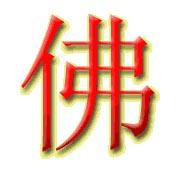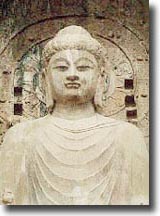
| Home | |||
| About Us | |||
| Overview | |||
| Shaolin | |||
| History | |||
| Practice | |||
| References | |||
| Hsing Yi | |||
| Tai Chi | |||
| Bagua | |||
| Baji | |||
| Health | |||
| Other Styles | |||
|
|
|||
| Links | |||
| Directory | |||
| News | |||
t has always seemed strange that many Shaolin practitioners who know that the Shaolin temple is the birthplace of Zen Buddhism do not go into details about the meaning of Zen or even the meaning of Buddhism.
If the art is founded on Buddhist philosophy, then the failure to acknowledge its roots amounts to practice without a foundation. This is why the Chinese Martial arts cannot and should not be considered purely as a sport, but as a way of life. In that sense, there can be no Shaolin Wushu, because this would only capture the external aspects, but training also has a practical side. Too much intellectualization without application is also meaningless.
Our discussion of the Shaolin philosophy starts with:
Buddhism is a rich and complex philosophy. The Buddhist path can be summed up as:
-
to lead a moral life
-
to be mindful and aware of thoughts and actions, and
-
to develop wisdom and understanding.
The teachings of the Buddha are based on the tenets of the Four Noble Truths and the daily practice of the Eight-Fold Path.
The Four Noble Truths
he tenets of the Four Noble Truths are:
-
life is suffering
-
suffering is caused by desire
-
suffering can be overcome and true happiness can be attained
-
the end to suffering can be achieved by following the Noble 8-fold Path
The Eight Fold Path
1. Right View - Understand the Four Noble Truths. It is desire that brings suffering, and letting go of desire can bring peace.
2. Right Thought - remove the fifteen defilement (greed, ill-will, hostility, denigration, dominance, envy, jealousy, hypocrisy, fraud, obstinacy, presumption, conceit, arrogance, vanity and negligence) by the six methods of removal (restraining, using, tolerating, avoiding, destroying, developing).
3. Right Speech - Speak only words of honesty, kindness, nurturing and worthiness.
4. Right Action - Do no harm (Respect life, Earn all that you have, Control your desire)
5. Right Livelihood - Does one's way of life support or hinder the ways of Peace? Only the heart knows.
6. Right Effort - Discipline and diligence in following the Eight-Fold Path.
7. Right Mindfulness - Aware of the body, feelings, mind and mental qualities.
8. Right Concentration - Focus on the Eight-Fold Path.

Zen
|
"A
special transmission outside the scriptures;
No
dependence upon words and letters;
Direct
pointing to the soul of man:
Seeing
into one's own nature and attainment of Buddha hood"
|
|
Bodhidharma,
First Patriarch of Zen
|
he differences in the various schools of Buddhism (Theravada, Mahayana, Vajrayana, etc.) are found in their method and approach. The teachings of Bodhidharma are based on self-cultivation through meditation and enlightenment, which occurred the moment he comprehended his Buddhist ego. This approach was a radical departure from the scholasticism of the traditional Buddhist sutras at that time. This change resonated within the Chinese minds and resulted in the dominance of this philosophy in South East Asia.
Implications for the Practice of Martial Arts
he influence of this philosophy on the practice of the martial arts should be clear. Unlike a sport, the practice of Shaolin Quan should lead to control of the ego. The basic principals of the Four Noble Truths and the Eight-Fold Paths are an inherent assumption underlying the spirit of the practice. In traditional views, the training in this art is done for oneself, and the desire to engage in it for sport represents a contradiction. On one level, the forms and postures are for fighting, but the ultimate goal is harmony between mind and body. Having a strong body and a strong mind will diminish and, ultimately, eliminate any perceived conflict.
Copyright 2003

